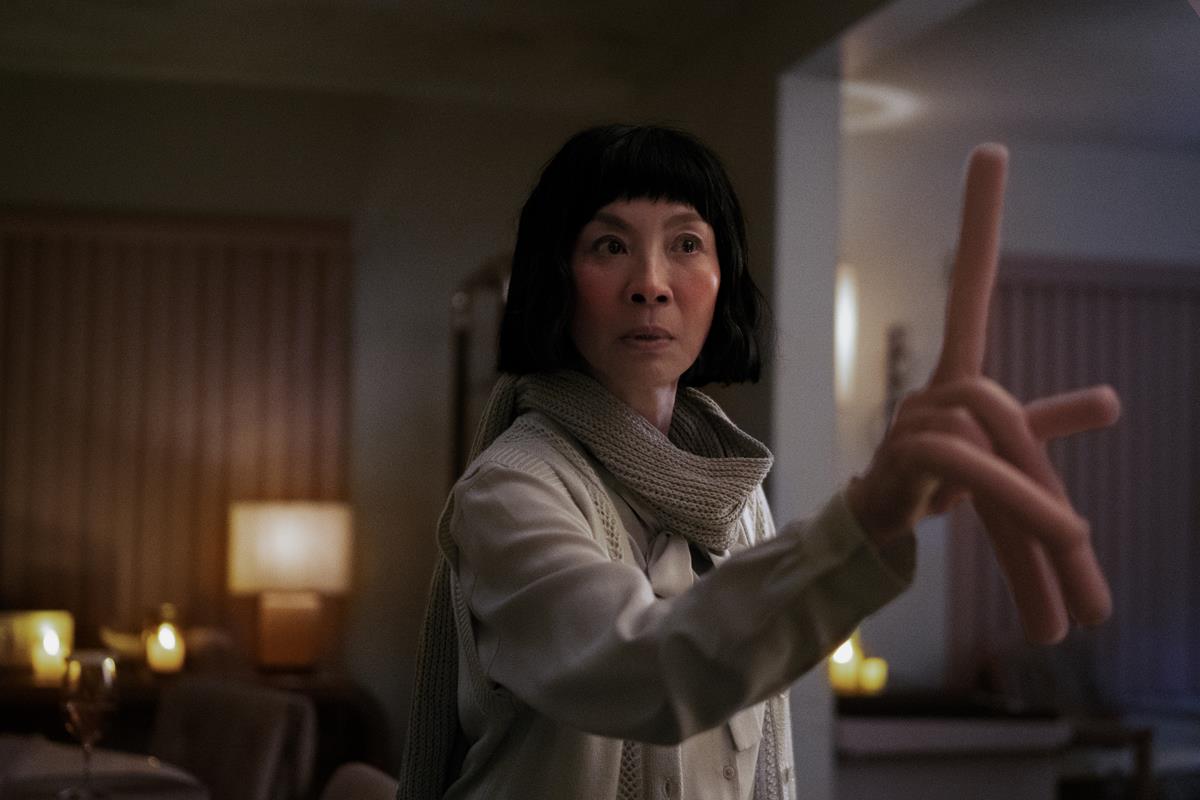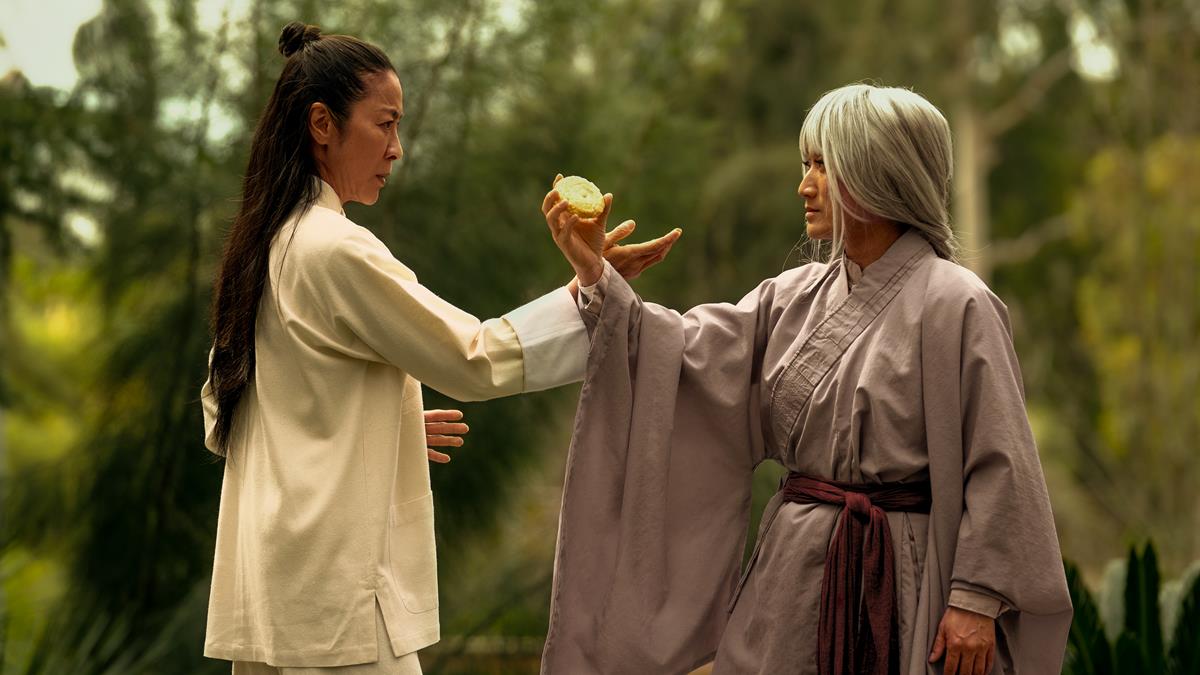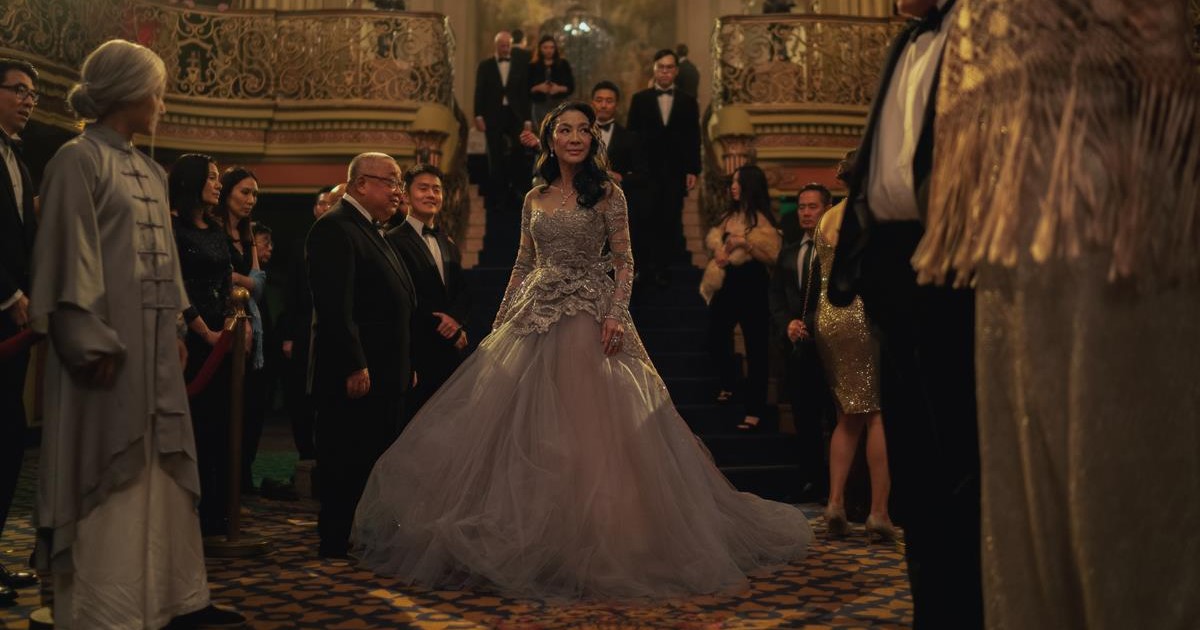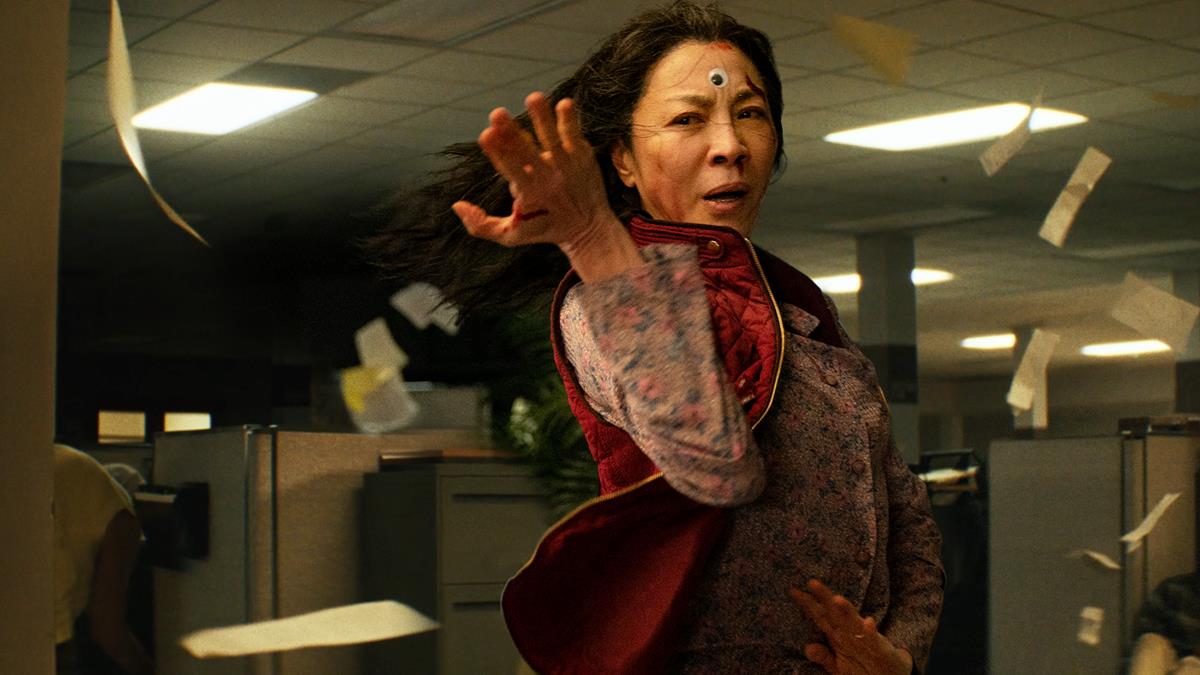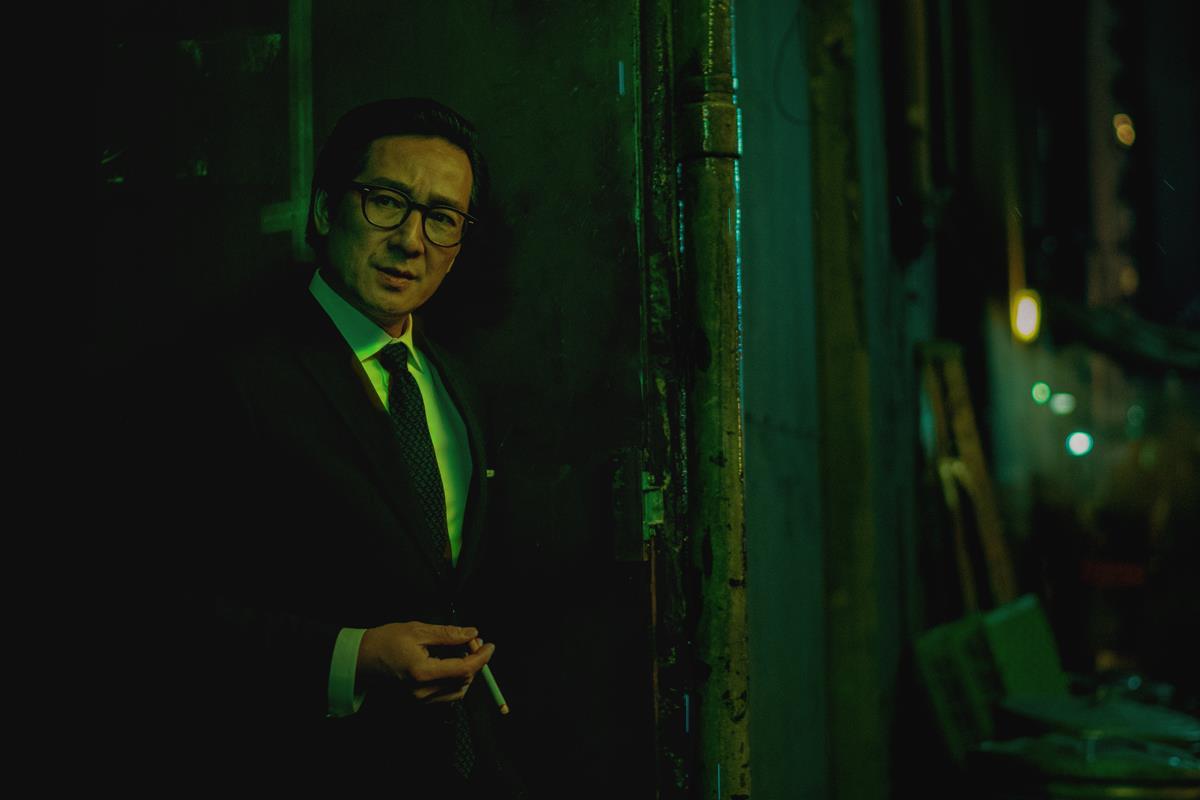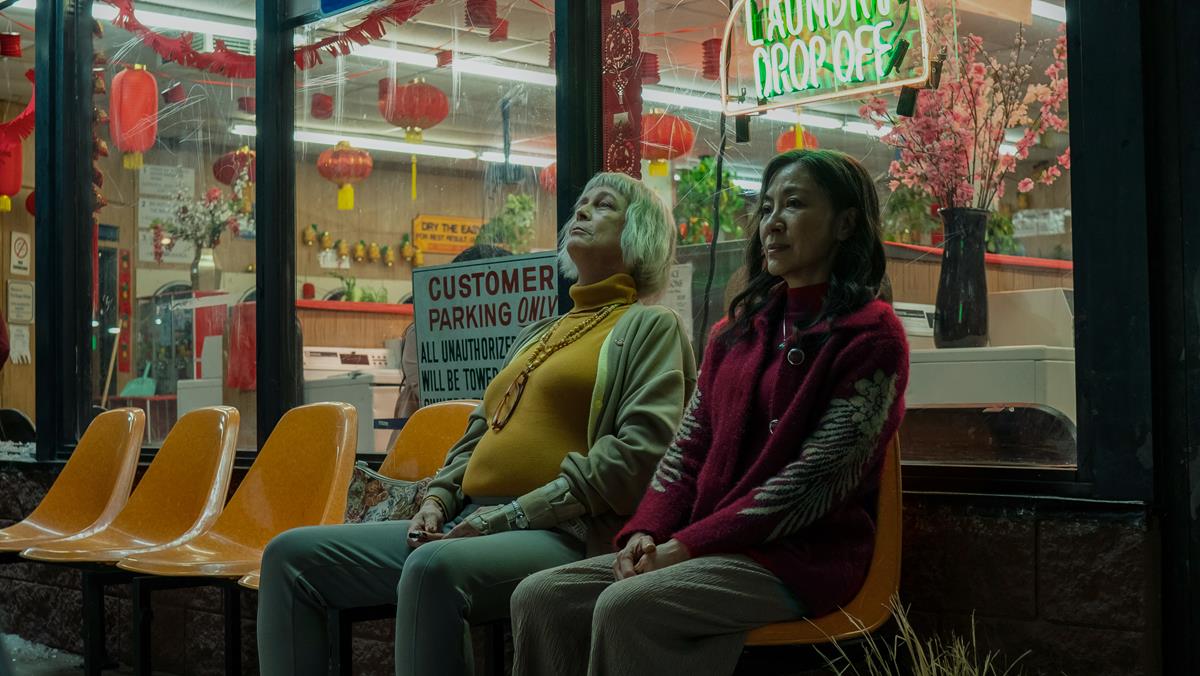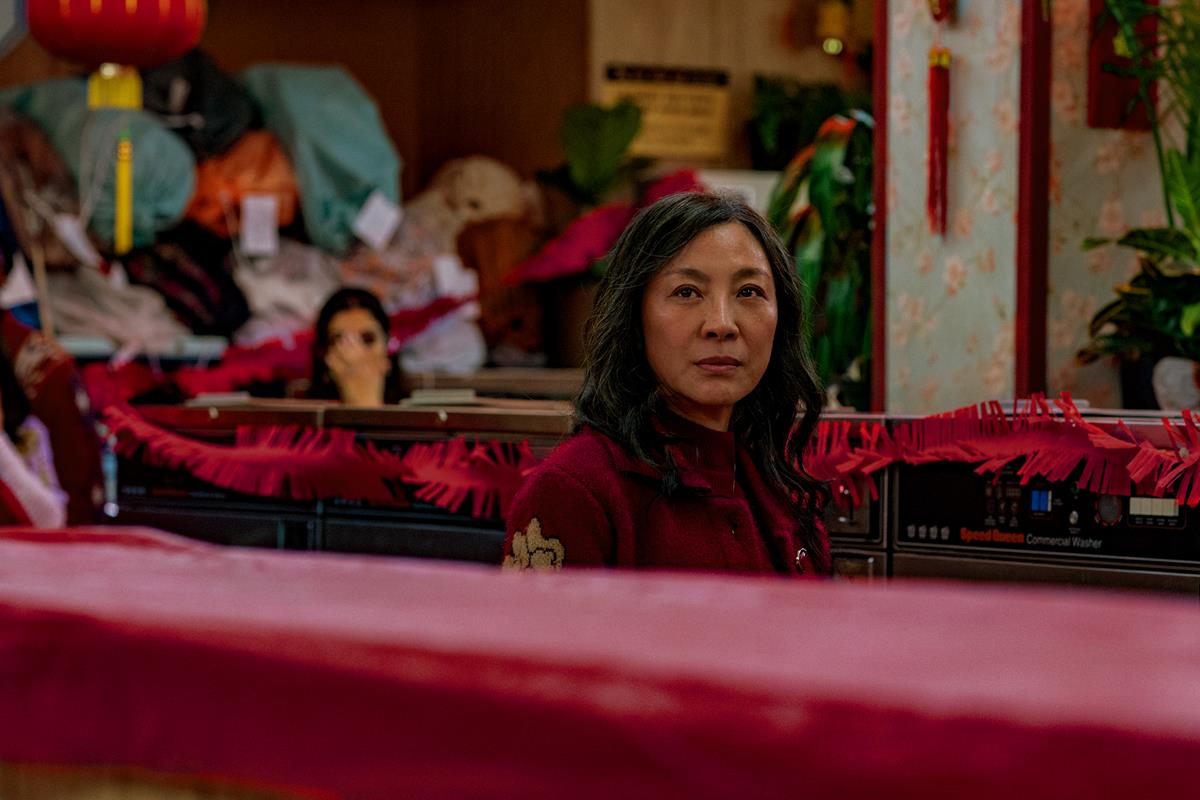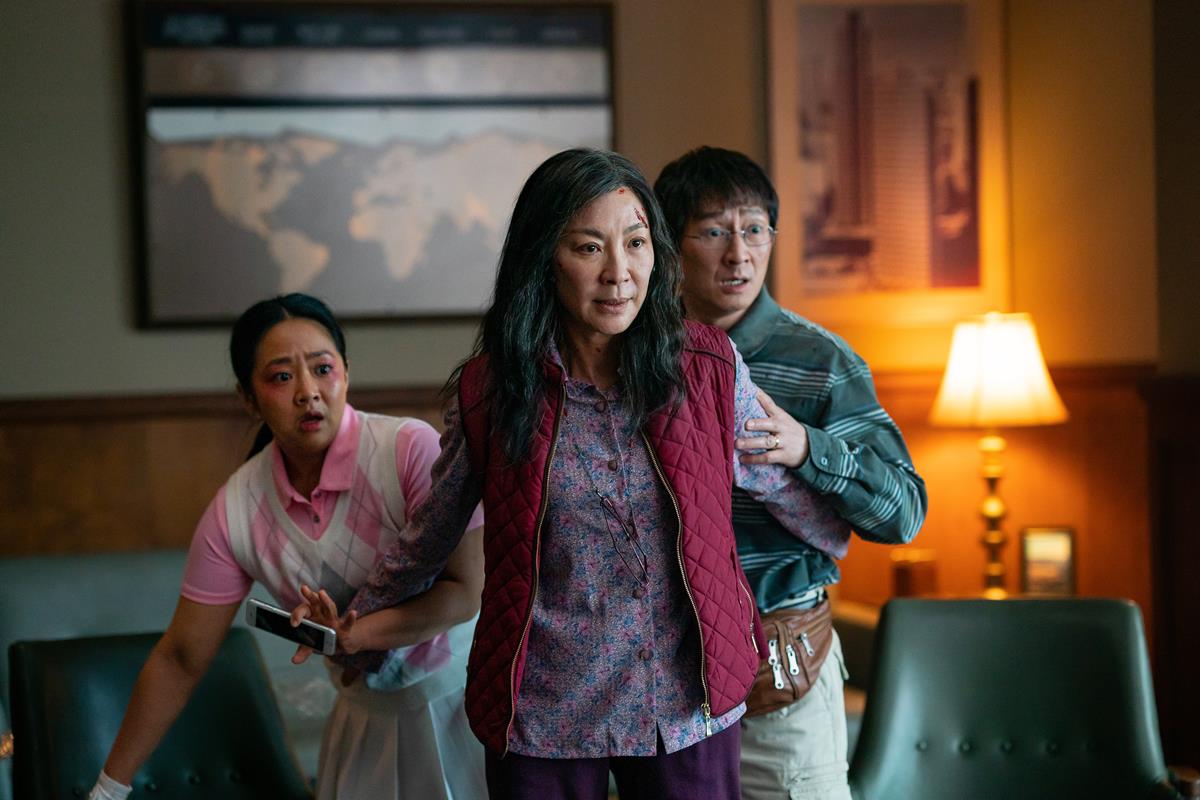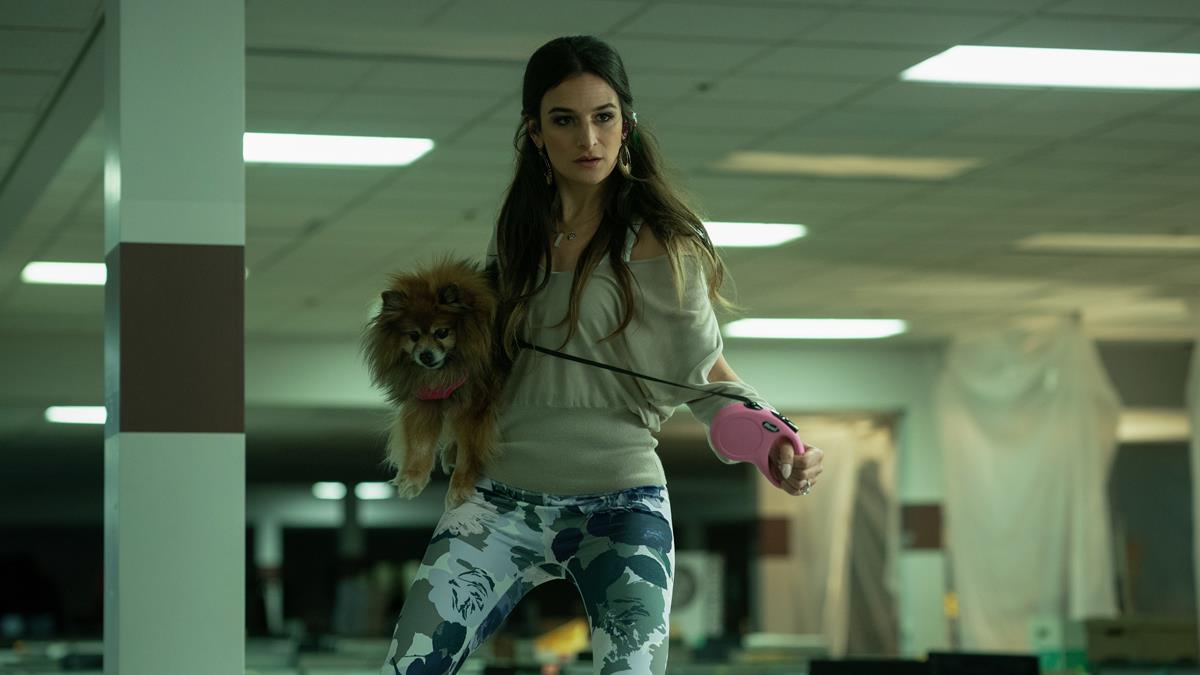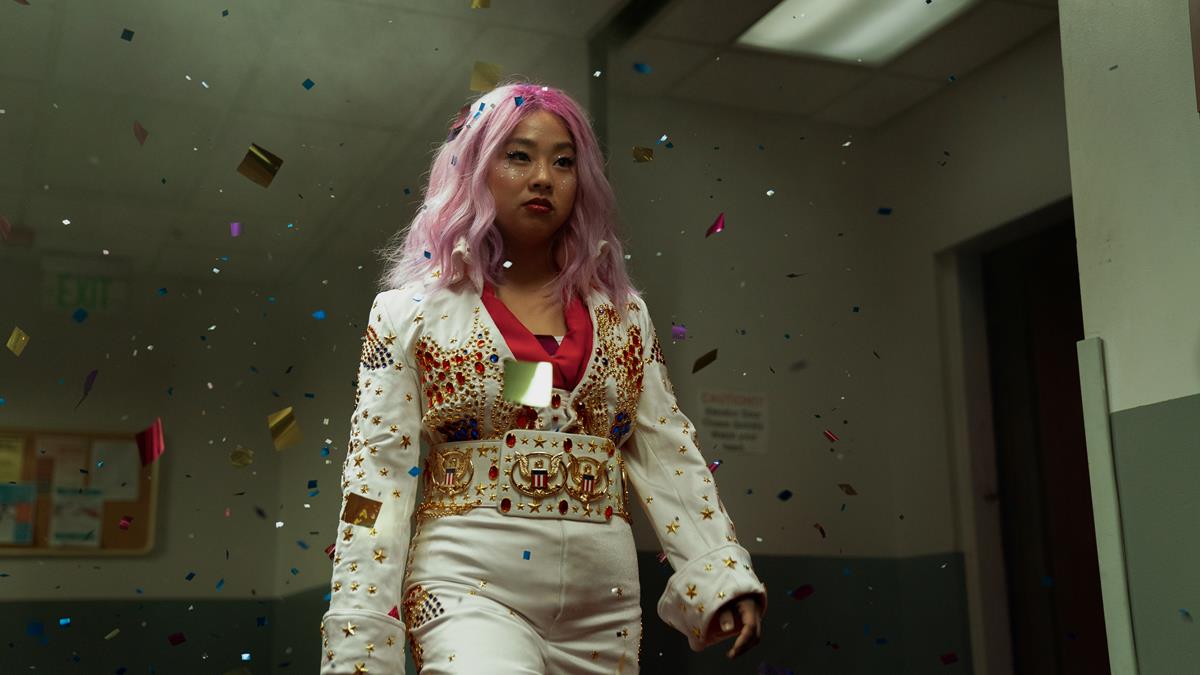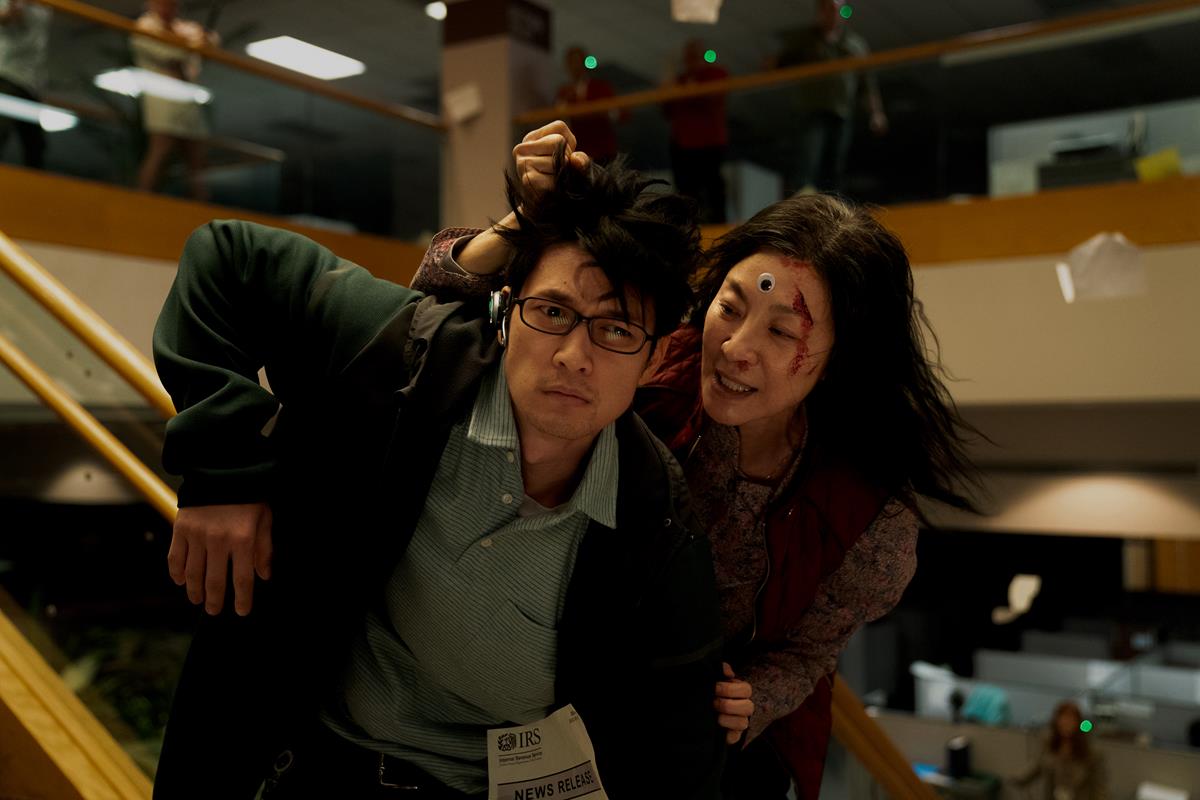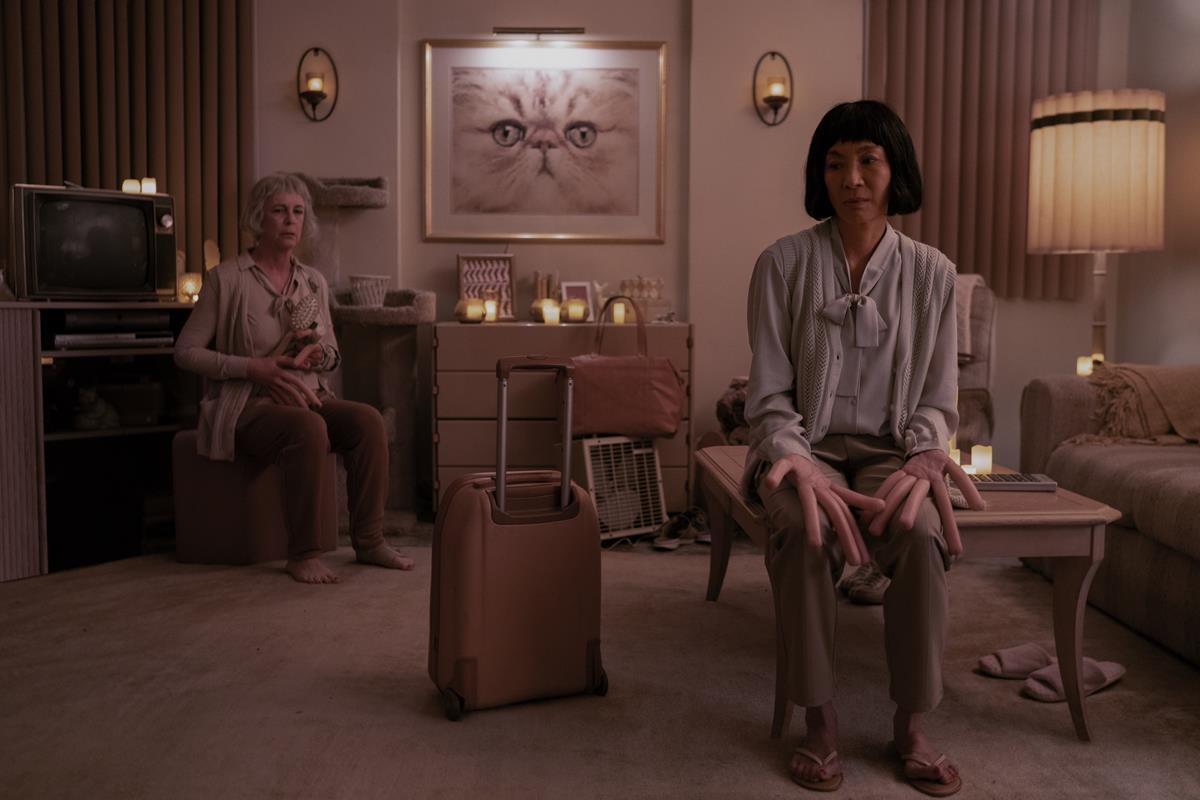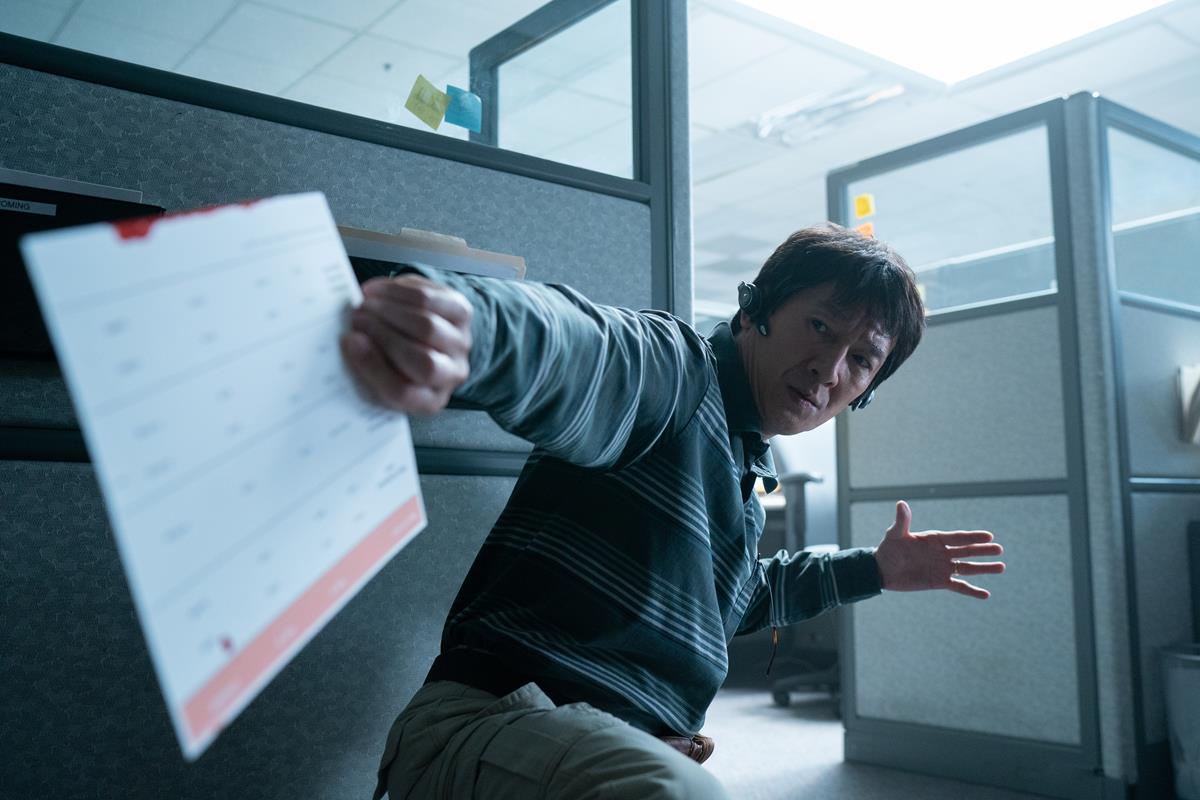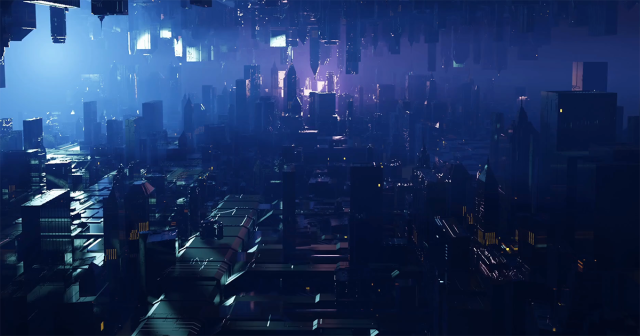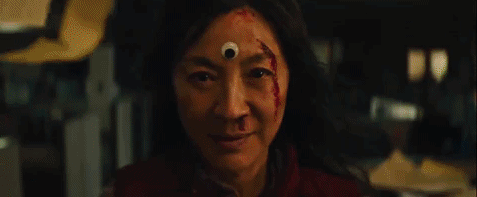
Everything Everywhere All At Once lives up to its title. The Oscar-winning sci-fi comedy feature “takes the red-pill mind-screw of The Matrix and multiplies it by infinity,” according to Variety’s Peter Debruge, but that doesn’t necessarily mean audiences can handle the “gnarly three-dimensional sudoku puzzle” that results.
The movie stars Michelle Yeoh as a woman named Evelyn Wang who learns that she can experience endless dimensions simultaneously, and uses that power to attempt a reconciliation with her estranged daughter.
The internal logic of the film is complex, but the gist is that different decisions cause splinters in time, and, somewhere out there, anything that could have happened actually did. So, that means there is a timeline where Evelyn is not the lowly laundromat owner we first meet but is also a huge Hong Kong action star, an opera singer, a maid, and a teppanyaki-style chef… ad infinitum.
Writers and co-directors Daniel Kwan and Daniel Scheinert — collectively known as the Daniels — made the equally absurd Swiss Army Man, about a man who befriends Daniel Radcliffe’s semi-sentient corpse. This time around, the creative duo has the Russo Brothers (Avengers: Infinity War) producing, with A24 and Ley Line Entertainment, IAC and Josh Rudnick exec producing.
The film rushes headlong into unruly anarchy: Evelyn is plunged into the metaphysical world of “verse-jumping,” veering from the mundane dreariness of a IRS building to the palatial lair of a nihilistic villain, to the flashing lights of Hong Kong red carpets, to a deserted canyon where sentient rocks have an extended on-screen chat.
Critics say the unhinged imagination on display here will leave viewers exhausted, but that could be intentional. The filmmakers believe they’re saying something about the impact of the metaverse on our ability to truly see those near us.
“We could say a million things about [the film], but the most simple, honest thing is it’s about a mom learning to pay attention to her family in the chaos,” Kwan says. “The biggest seed that drove us through — that felt like a metaphor for what we’re going through right now in society — is this information overload.”
He adds, “People keep saying ‘empathy fatigue’ set in with Covid, but I feel like even before covid we were already there — there’s too much to care about and everyone’s lost the thread. That was the last key, turning this into a movie about empathy in the chaos.”
Information Overload
In an era of information overload, extreme polarization, and mass existential dread, the struggle to connect with family might feel less like a banal, everyday experience, and more of an increasingly confounding battle between a loved companion and a mortal enemy.
“In a lot of ways, the movie is just a family drama,” Scheinert says, “and then we came up with some of the most insane, enormous, overcomplicated hyperbolic metaphors for generational gaps, along with communication errors and ideological differences within a family.”
The film slyly tweaks the “hero’s journey” story beats that audiences have come to expect, squishing and stretching a three-act structure as if the movie itself were jumping through a fracturing multiverse.
“The result is a mess,” says Debruge, “but a meticulously planned and executed mess, where every shot, every sound effect and every sight gag fits exactly as the Daniels intended into this dense and cacophonous eyesore, which endeavors to capture the staggering burden of trying to exist in a world of boundless choice.”
The Daniels wanted that sense of infinity — of all of the possible worlds, the depthless rabbit holes, and all of the tiny moving pieces underneath it — to remain top-of-mind for the audience, even if that meant fraying their minds.
“There are enough ideas in Everything to fuel a dozen movies, or else a full-blown TV series, but the Daniels have shoehorned it all into a bombastic, emotionally draining 139 minutes,” writes Debruge.
“Moviegoers with limber imaginations may well appreciate the lunatic ambition and nutso execution of this high-concept hurricane, which ricochets like a live-action cartoon for most of that duration. But less versatile viewers will emerge frazzled, like Wile E. Coyote after swallowing a stick of dynamite: their heads charred, blinking blankly as smoke wafts from their ears.”
READ MORE: ‘Everything Everywhere All at Once’ Review: Chaos Reigns – and So Does Michelle Yeoh – in Unhinged Metaverse Movie (Variety)
A Family Affair
The idea of generational love grounds the wildly chaotic narrative of Everything Everywhere All At Once, as Charles Pulliam-Moore notes at The Verge.
“It became our guiding light very early on,” Scheinert told Pulliam-Moore, describing how making the film about a family gave the Daniels free reign to experiment with some of their more outrageous ideas. “But the litmus test would be like, does that complement the journey of this family? A surprisingly weird array of things still complement the story of this family because they’re all distractible, and so anything that distracts them in a new and interesting way becomes a potential path,” he explains.
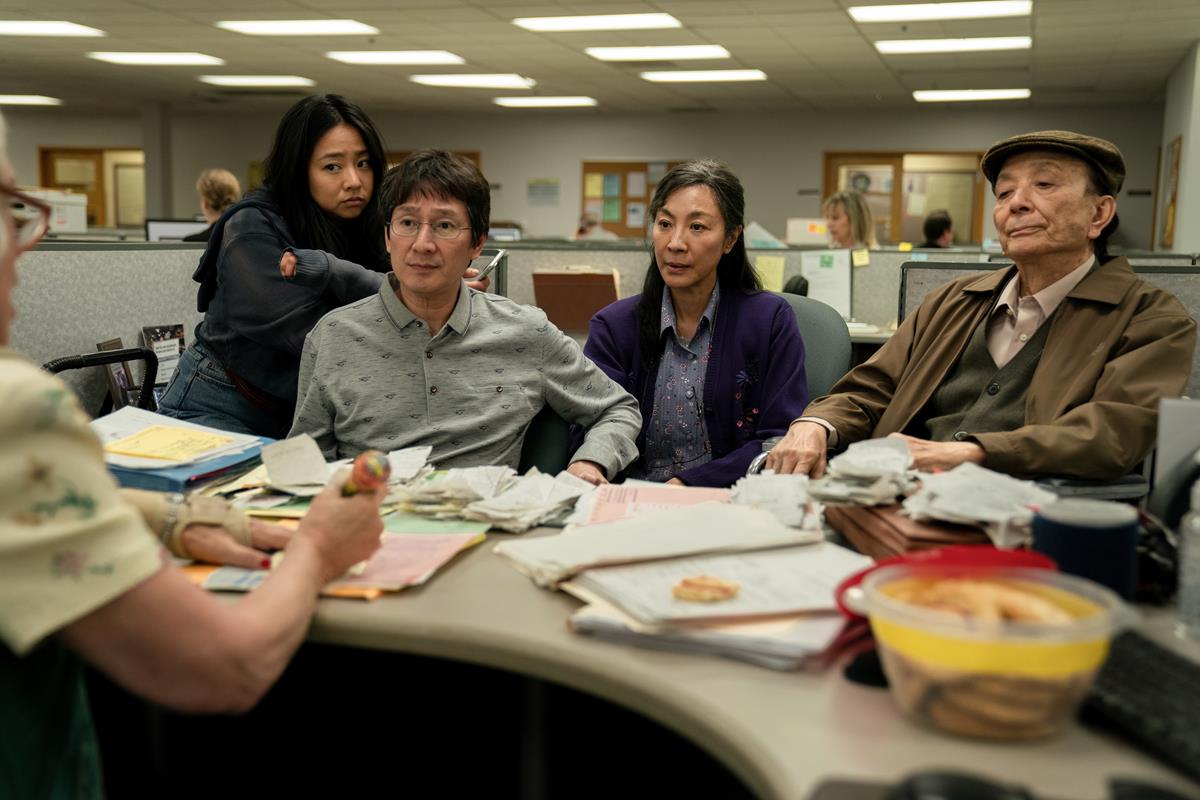
“I think one of the things about generational love that we kind of came to while making this was empathy,” Scheinert continues. “We tried to make an empathetic story about how hard it is for our parents’ generation to understand our generation. We tried not to oversimplify that idea by doing an ode to how beautiful it is when someone who grew up in a completely different way goes on the brave journey of trying to understand and support someone so different from themselves.”
“One of the things we realized was, like, we are going to be the old people soon,” Kwan added. “If progress is to happen, the older generation has to be willing to listen, and hopefully, they will listen in the way that they wish they were listened to. And the young generation will have to be kind and patient in the way that they hope that the next generation will be kind and patient with them. It’s obvious to say, of course, but it’s… I think it’s one of the hardest things any human has to do, and I’m hoping that this movie creates space for that kind of conversation because we’re in the middle of it right now. We need that kind of conversation.”
READ MORE: The Daniels See Everything Everywhere All At Once as a Story About Generational Love (The Verge)
NPR film critic Justin Chang agrees: “For all its cosmic craziness, Everything Everywhere All At Once has a simple emotional message: It’s about how the members of this immigrant family learn to cherish each other again,” he notes in his review.
“It’s also about making peace with the life you’ve lived — and the ones you haven’t. And that sort of sums up how I feel about this funny, messy, moving and often exasperating movie: There may be a better, more focused version of it in some other universe, but I’m still grateful for the one we’ve got.”
READ MORE: There’s a multiverse of roads not taken in ‘Everything Everywhere All at Once’ (NPR)
Order From Chaos: The Cloud-Based Post Process
Most of the visuals for Everything Everywhere were captured in a warehouse in Simi Valley. “It was big enough that we could wreck one part of the building, then walk away and just go somewhere else in the complex to continue filming while our team restored the initial part of the building,” says production designer Jason Kisvarday.
The film was shot by Swiss Army Man DP Larkin Seiple and edited with manic intensity by Paul Rogers using split screens and blurry overlay effects.
“The directors don’t shy away from the use of dizzying flashing lights, or rapidly shifting light sources that disorient the viewer,” Aurora Amidon notes in her review for Paste. “They also aren’t afraid to implement over-the-top images, like a person’s head exploding into confetti or a butt-naked man flying in slow-motion toward the camera. At the same time, movement between ‘verses feels seamless through Rogers’ meticulous editing, as does the effortless fashion in which different aspect ratios melt into one another.”
READ MORE: Everything Everywhere All at Once Achieves the Impossible (Paste)
Rogers, who has also edited the feature films The Death of Dick Long and You Cannot Kill David Arquette, and the TV series Dream Corp LLC and The Eric Andrew Show, discussed how Everything Everywhere was assembled with The Art of the Cut podcast host Steve Hullfish.
“They pitched it to me as ‘We want to make a film, and then we want to break that film, and then we want it to rebuild itself,’” he recounted during the episode.
“It’s hard to describe,” he adds. “It just reaches a point where you have to let go of trying to hold it together as a viewer in your mind, and trying to make sense of everything and fit everything together. You’re going on this journey with Evelyn, the character, and part of her journey is learning to let go.”
During editing, Rogers used Adobe Premiere Pro to create split screens and other effects. “Premiere has always been wonderful because it disappears when I’m using it,” he says.
“I love to split the screen and combine performances or just change the timings between actors, make someone react or speak over a line versus waiting their turn. And I love to be able to do that in a two shot or a wide shot, but that’s just not how the scene plays out.
“So I use Premiere all over this film to do that, to the point where I just didn’t tell them. When they got into finishing the VFX supervisors, Zak Stoltz said there were about 30 VFX shots that he wasn’t aware of. There are all these little split-screen things or changing an extra out in the background, or, even a prop.
“Sometimes the way a prop was placed was better in one shot than another shot, so I would throw that in. I can temp together VFX in Premiere in a heartbeat.”
Listen to the full episode in the player below:
Watch Rogers discuss the collaborative, cloud-based post workflow for Everything Everywhere All At Once at the 2022 NAB Show with Adobe’s Meagan Keene:
You can also watch Rogers and Keene in conversation on the NAB Amplify stage at the 2022 NAB Show:
Infinite Storytelling Possibilities
While Everything Everywhere offers a treasure hunt of eclectic cinematic references — ranging from 2001: A Space Odyssey and In the Mood For Love to Ratatouille — Kwan insists their voice is far from that of a cinephile, but was honed rather through things like YouTube videos, Tim and Eric sketches, and the form-breaking anarchy of Japanese anime movies.
“We would put our stuff online, and the algorithm would push it because it was so insane, and then we’d get attention and that positive reinforcement,” Kwan recalls. “We were like, oh, I guess we should be more insane.”
The film is also their response to other multiverse sci-fi movies that annoyed them. Star Trek’s 2009 reboot by JJ Abrams might have featured two Spocks, but they felt this twist didn’t make near enough of the mind-bending opportunity.
“My pet peeve is time travel when you introduce it and just do a tiny bit like it’s no big deal,” Scheinert told Eric Kohn at IndieWire. “It would be such a big deal! Like if logic broke down and time didn’t move forward and a million people could go back in time a million number of times there’d be absolute chaos.”
“This movie is 100 percent a response to The Matrix, obviously,” Kwan added. “We wanted to make our version of it.”
READ MORE: ‘Everything Everywhere All at Once’ Directors Turned Down ‘Loki’ to Direct Their Own Multiverse Comedy (IndieWire)
He’s specifically talking about the original Matrix film’s iconic fighting scenes. “There’s something so entertaining and visceral about it, and we wanted to try to take that kind of energy and satisfying filmmaking and point it towards love and understanding,” Kwan says. “We don’t know how to do that, but we want to see it on the big screen.”
The film has also just satirized the trajectory of Marvel’s ever-expanding universe. With an MCU increasingly folding over on itself with actors playing the same (or different versions of) characters from past movies (Spider-Man: No Way Home) or opening portals into other storylines (the entire Loki series — which the Daniels apparently turned down an offer from Marvel to make), not to mention explicit references as in the forthcoming Doctor Strange in the Multiverse of Madness, it’s clear that the multiverse will be a recurring theme for years to come.
“It’s no wonder that the idea of the multiverse is so popular within the sci-fi genre when there are infinite storytelling opportunities,” Gavin Spoors observes at Space. “When films like Spider-Man: Into the Spider-Verse come around, it proves how powerful and exciting the multiverse can be. With infinite universes, comes infinite possibilities.”
READ MORE: Why is the multiverse so popular in sci-fi at the moment? (Space)
Want more? In this episode of Vanity Fair’s “Notes on a Scene,” Everything Everywhere star Michelle Yeoh and directors Daniel Kwan and Daniel Scheinert discuss how they filmed this action-packed fight scene between Evelyn and Deirdre:
Talking to Insider, stunt coordinator Timothy Eulich and fight choreographers Andy Le and Brian Le break downhow the movie’s most impressive action sequences came together. From classic Hong Kong movies and Jackie Chan action figures to break dancing and parkour, Eulich and the Le share what inspired them and the various references they used for Everything Everywhere.
In an episode of NPR’s Short Wave podcast with host Emily Kwong, the Daniels break down how an indie film about laundry and taxes blends the arts with sciences:
Watch the Daniels break down the scene where Waymond (Ke Huy Quan) uses his fanny pack to take down a phalanx of security guards.
“Every good action movie has to have a good kickoff action sequence,” Kwan says, adding that the directors wanted to “show off what this movie is going to be, but in a way that is mysterious, in a way that hopefully causes you to ask a lot of questions and want to keep watching.”
Confused about why Evelyn Wang places a googly eye on her forehead during the film’s climactic sequence? In this video essay, Accented Cinema explains it all, breaking down the hidden metaphors within Everything Everywhere All At Once:
The Daniels also sat down with visual effects artist Zak Stoltz to discuss how the small budget for the film forced them to get creative, especially when it comes to the special and visual effects, in order to create something unique:
Want to learn more about the sound of Everything Everywhere All At Once? In an interview with Dolby, sound designer and sound effects editor Andrew Twite and re-recording mixer and sound supervisor Brent Kiser are joined by the Daniels to discuss their creation.
“We knew we wanted to create something that somehow bridged the gap between big blockbuster action films and really intimate risk-taking indie films,” says Kwan. “And we wanted to find a way to do both at the same time. To carve out space for independent films in theaters, because that’s something that’s slowly being carved out more for these big, big IP blockbuster films.”
If you’re looking for more candid moments with the duo, Alamo Drafthouse asked the Daniels to pitch a concept on the spot for a Don’t Talk/Don’t Text PSA that goes… very sideways:
Exploring the Cinematic References of “Everything Everywhere All At Once”
From The Matrix and Ratatouille to the films of Wong Kar-wai, the hit indie sci-fi feature from the Daniels is filled with “trippy cinematic homages,” writes Vanity Fair’s Yohana Desta.
By Jennifer Wolfe
Over at Vanity Fair, Hollywood writer Yohana Desta takes a deep dive into Everything Everywhere All At Once, examining the abundance of movie homages the Daniels managed to pack into their hit indie sci-fi feature.
Characterizing the film as “a giant nerd,” Desta says, “It’s also a whirlpool, a fun house, an unpredictable Russian doll of ideas and feelings and things, dense with trippy plot points about parallel universes and metaphors about familial love and acceptance. But it’s also a movie about movies, layered with references that not only pay homage to classic films of the past, but also reanimate them with unhinged verve.”
The Matrix
“This movie is one hundred percent a response to The Matrix, obviously,” Daniel Kwan said ahead of the film’s SXSW premiere, Desta notes. “We wanted to make our version of it.”
The film’s press notes detail an afternoon double feature of The Matrix and Fight Club Kwan saw in 1999, and how the experience helped reinvigorate his love of cinema. “I was like, man, if I could just make something half as fun as The Matrix is, but with our own stamp and our spirits, I would just die happy,” he said.
Kung Fu Classics
Everything Everywhere All At Once contains countless nods to martial arts, as Desta observes, including classic kung fu movies such as Clan of the White Lotus, and more recent movies like Quentin Tarantino’s Kill Bill series.
“The biggest nod arrives in the form of Evelyn’s kung fu master, played by Li Jing,” Desta writes. “With her fluffy white eyebrows, mustache, and beard, she’s a direct play on the classic Bak Mei, or Pai Mei character, a kung fu master whose likeness has been portrayed in numerous 1970s and 1980s-era Hong Kong films like Clan of the White Lotus and Executioners From Shaolin.”
2001: A Space Odyssey
Everything Everywhere riffs on the classic opening sequence of Stanley Kubrick’s 2001: A Space Odyssey, which shows early hominids discovering the monolith featured in the sci-fi classic.
“But the scene also delivers the viewers into a rather peaceful moment in the otherwise chaotic film,” Desta points out: “In one of her parallel lives, Evelyn is a prehistoric rock, silently observing and enjoying the natural world… for a few moments, anyway.”
Ratatouille
“Nowhere is Everything Everywhere more chaotically unbridled than in the ‘Racacoonie’ scenes,” Desta writes, pointing to the film’s hilarious send-up of Pixar’s animated hit Ratatouille, which has Evelyn fighting a rival hibachi chef controlled by a racoon hiding under his toque.
“But the Daniels don’t just float the concept as a comic idea,” she says. “They follow through, returning again and again to the subplot as Chad loses Racacoonie to villainous pest control and, with the help of Evelyn, rescues his furry friend. Rescuing Racacoonie becomes part of the narrative, showing Evelyn’s strength and dogged pursuit of being the hero.”
In the Mood for Love
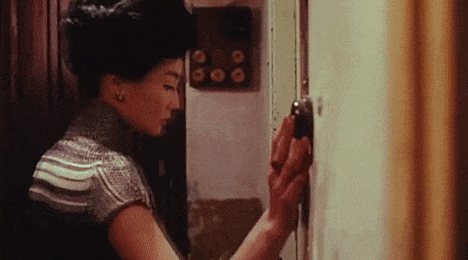
“In terms of style and narrative, the Daniels could not be further from someone like Wong Kar-wai,” Desta hypothesizes, “And yet, during a handful of scenes in Everything Everywhere, the duo pays painstaking homage to the director’s oeuvre, particularly his 2000 classic In the Mood for Love.”
One of Evelyn’s parallel lives is an action movie hero, much like the film’s star, Michelle Yeoh, and Everything Everywhere employs real-life sequences of Yeoh on the red carpet to depict her counterpart. Some of the the most moving moments occur between movie star Evelyn and her husband, Waymond (Ke Huy Quan), evoking the lush, moody visuals of the Chinese film director’s 2001 art house hit.
“…In that parallel life, Evelyn learns that her success is only possible because she chooses not to be with Waymond, forging a different path ahead,” writes Desta. “Waymond somehow finds his way to the premiere of her latest movie, and the two go outside for a one-on-one conversation. It’s moody and dark, stylized with the same romantic energy as the corridor scenes in In the Mood for Love, in which Tony Leung and Maggie Cheung play two neighbors who can never be together, and must resort to exchanging longing looks that no one else can catch.”
READ MORE: Everything Everywhere All at Once: All the Wild Movie References, Explained (as Best as We Can) (Vanity Fair)
“Everything Everywhere All At Once” Is an Ode to the Internet
By Abby Spessard
If Everything Everywhere All At Once reminds you of the internet, that’s not an accident. The Daniels — filmmaking duo Daniel Kwan and Daniel Scheinert — wanted their film to reflect the tumultuous, rapid-fire zeitgeist of the vast global network that comprises the World Wide Web.
The movie portrays the “uncanny delirium of digital life,” Alex Pasternack writes for Fast Company, complete with “doomscrolling and context-collapsing and flipping between wildly divergent and often confounding realities — between videos of war and wildfires and an awards-show slap — and whatever all of this is doing to our brains and our relationships.”
Speaking with Pasternack, the Daniels shared how they questioned whether a film set in the absurd chaos of infinite universes could have any meaning. Because if everything is possible, does any of it matter?
As it turns out, yes. We create our own meaning, just as we do online. The internet is a form of multiverse in itself, Pasternack argues, capable of creating unique realities for every individual person who uses it. “In the metaverse as in the multiverse, you can see things and perspectives you never knew existed — or you can live in whatever world you please, all others be damned,” he comments. “The characters of Everything don’t mention the internet, but it looms over everything.”
The Daniels conjure Evelyn Wang (Michelle Yeoh) and Joy Wang (Stephanie Hsu), a mother and daughter duo struggling with their own multiple identities. Joy’s alter ego, Jobu Tabacky, is “a bizarro, omnipotent version of Evelyn’s daughter,” as Pasternack writes, who personifies the worst parts of the internet, creating an Everything Bagel of doom that threatens the very existence of the multiverse.
The film’s high stakes echo the equally high stakes we experience in real life.
“Specifically for us: we are millennials, we grew up on the internet, we were the first generation to do so, and our parents didn’t,” Kwan explains. “And so I think that made that gap just a chasm. And so the movie uses the multiverse almost as a metaphor for how the internet has destroyed our minds. And how our parents are trying to figure out how to fix this.”
READ MORE: ‘Everything Everywhere All at Once’ is an antidote to the superhero movie (Fast Company)
Award Recognition
After more than year’s worth of buzz, “Everything Everywhere All at Once” fulfilled the promise of its critical acclaim at the 2023 Academy Awards. The A24 film was the biggest winner of the evening, taking home Oscars in seven categories, making it the “most-awarded best picture winner since 2008’s ‘Slumdog Millionaire,’” per Variety.
EEAAO’s wins:
- Best Picture
- Best Actress (Michelle Yeoh)
- Best Supporting Actor (Ke Huy Quan)
- Best Supporting Actress (Jamie Lee Curtis)
- Best Director (Daniel Kwan and Daniel Scheinert)
- Best Original Screenplay (Daniel Kwan and Daniel Scheinert)
- Best Film Editing
It was also nominated for Best Costume Design, Best Original Score, and the film’s Stephanie Hsu was also put forward for the Best Supporting Actress category but lost to Curtis (and her hotdog fingers).


